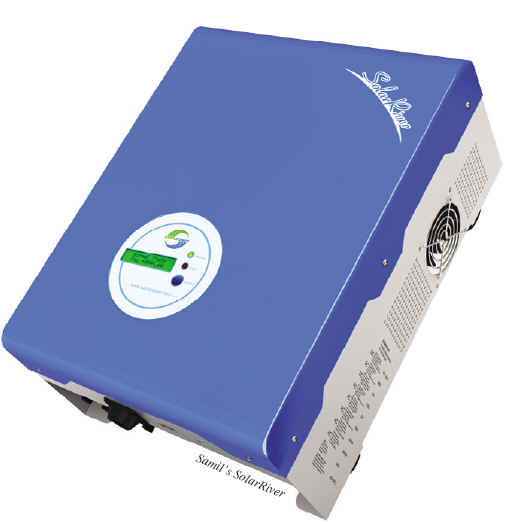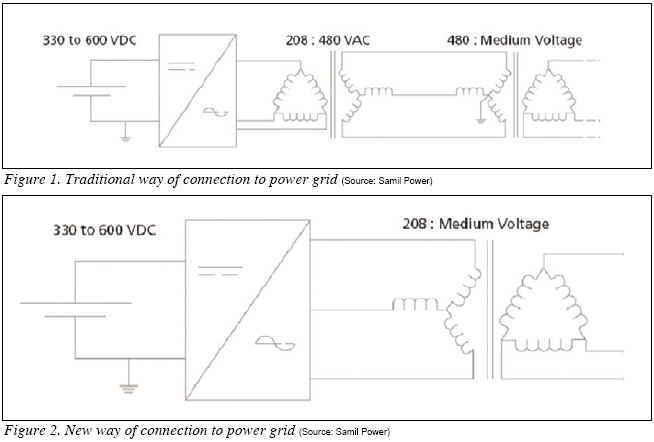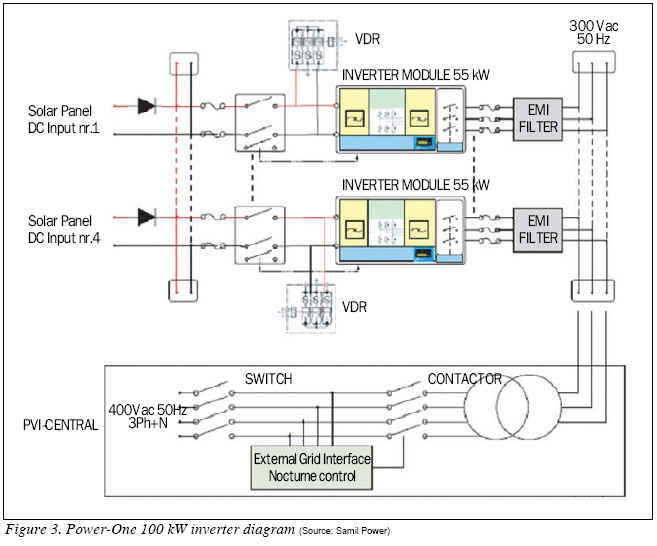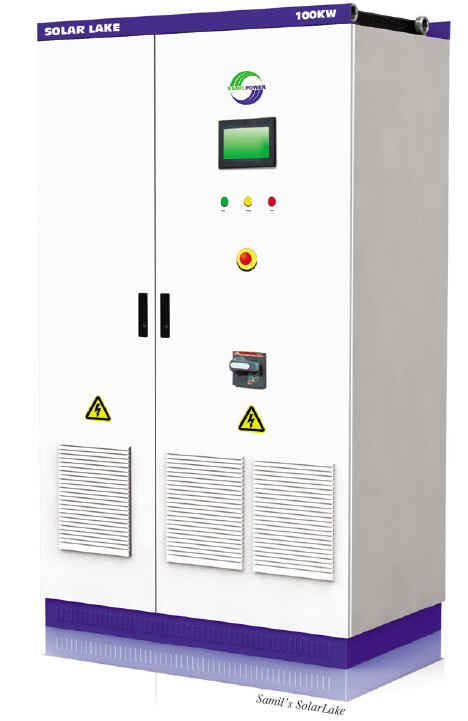BY Degang Yi

Global Technical Analysis
Currently, PV inverter market mainly focuses on Europe and the U.S., and European PV inverter manufacturers dominate the whole market. In global top 10 manufacturers in terms of market share, about 8 are from Europe, in which SMA accounts for 44% global market share, Kaco for 10%, Fronius for 9%, Ingeteam for 7%, and Siemens for 6%. In the U.S., only Power-One and Phoenixtec are in top 10. In Canada, Xantrex is also very famous. Big-power PV inverter usually refers to the one with output power over 100 kW, which applies to grid-connected PV plant. Big-power PV inverter, due to its high development cost and technical barrier, is always monopolized by some companies.
Big-power PV inverters can be divided into 2 categories in terms of isolation way: transformer inverter and transformerless inverter. In terms of structure, they can be divided into stand-alone big-power inverter and modularized parallel inverter. Below are the analysis of its technical characteristics, advantages and disadvantages:
Big-power PV isolation transformer is usually frequency transformer. Main benefits with frequency transformer are: First, solar inverter with buck-boost function will be very adaptable. Different power grids and solar panels are suitable for the same solar inverter. The only difference is the transformer ratio. Also, considering safety regulations, the U.S. market so far has been mandatory for solar inverter with isolation transformer. But the additional frequency transformer will increase the size and weight of inverter, which increases its cost dramatically.
Besides, the efficiency of frequency transformer is between 98% and 99%, thus different materials will lower the efficiency, prolong the time of harvest and decrease the expected benefits. Based on these reasons, foreign big-power PV inverter solves the problem from two aspects caused by transformer: the first one is to optimize the system framework, and the second one is to improve transformer efficiency.
General diagram of PV plant (see Figure 1), with input voltage ranging from 300 Vdc-600 Vdc for example, connect inverter to 400 Vac power grid through low-voltage transformer, and then once again, through transformer, connect it to 10 kV medium-voltage power grid.
The whole system through two-level transformers to connect to medium-voltage power grid, which increases the cost of system and lower the efficiency by 1%-2%. The current trends of foreign PV plants are using a new way to connect into power grid (see Figure 2). Without middle low-voltage transformer, using directly low-to-medium voltage transformer, can reduce cost and boost efficiency.
Low-medium voltage transformer is used in the external of inverter and configured by system manufacturers or electric power companies, so transformerless big-power PV inverters become more and more widely used. What’s more, to improve the transformer efficiency, new magnetic materials can be used to improve its performance. For example, big-power PV inverter with magnetic core made from amorphism, full-load efficiency can be over 99%. Big-power SC100/200/250/300 series transformer inverter of SMA, with high-performance transformer, maximum efficiency is up to 97.6%, Europe efficiency 97%, while its SC100HE/250HE/ 400HE/500HE/630HE series transformerless inverter, maximum efficiency is over 98.2%.
Modularized parallel inverter is a new idea in recent years, which actually comes from the concept of UPS. Parallel connection can generate redundancy and achieve high reliability. Small power modules can achieve high-frequency technology, reduce the size, increase power density and reduce the noise. Meanwhile, it can reduce cost of development, make flexible configuration and meet customer needs to the fullest. Its typical model is PVI-CENTRAK-100/200/250/300 series inverter of Power-One. In its system diagram (see Figure 3), it consists of two 55 kW power modules, on input side one or several strings can be connected, parallel on output side. Modularized inverter, through reasonable configuration, only operates part of the module under light load, which can improve system efficiency and reduce current harmonics when connected to power grid. But modularized big-power inverter needs to confront special problems in parallel, especially when input is one string, modules’s circulation needs to be solved.


Chinese Technical Analysis
The start of Chinese solar inverter manufacturers is relatively late. The first solar inverter manufacturer in China, Hefei Sungrow was established by Hefei University of Technology about 10 years ago. Benefited from state support for low-carbon economy, Chinese solar inverter manufacturers developed rapidly in the last two years, but still very small compared to foreign companies, technology and reliability need to be improved. Efficiency, for example, is regarded as the most important indicator to measure the level of solar inverter technology, Chinese 100 kW transformer inverter’s maximum efficiency is about 96%, which still needs a long time to catch up with foreign companies. In addition, due to lack of practical application, reliability cannot be greatly improved in the short term. There are more and more big-power inverter manufacturers emerging in China, but most of them are with a single inverter model and almost with similar technology.

Technical Difficulties
Improving Reliability
Currently, life expectancy of PV inverter is mainly constrained by electrolytic capacitors; Warranty period is generally 3-5 years. Usually, an electrolytic capacitor needs to be replaced about each 3 years. How to improve its life expectancy in nearly 20-year period without maintenance is an urgent problem to be solved.
Improving Adaptability of Power Grid
International standard tests require simulation grid with AC source, but in practice, power grid is very complex and varied. How to make solar power inverter generate as much as possible and have no effect to power grid still needs further study.
Improving Grid-friendliness
Europe has a requirement of Low Voltage Ride Through (LVRT) to wind energy converter, which helps power grid to recover in case of failure and to increase the proportion (permeability) of the entire energy structure. Solar inverter output active and reactive power is expected to be adjustable.
All these technical problems are both difficulties and opportunities. Foreign big-power inverter manufacturers have just started to study these requirements.
Technical Advantages
Since its beginning, Samil Power has focused on R&D of big-power inverters, and has brought together a large number of senior R&D professionals with a goal of high reliability and high efficiency. Its first 100 kW PV inverter will soon enter the market with over 97% maximum efficiency. To keep up with international technological trend, 500 kW transformerless PV inverter is also under intense development.
For the technical difficulties, Samil Power stand out with its own unique and better solutions, which makes its products more competitive. Firstly, by further increasing reliability through replacing electrolytic capacitors for the film capacitor, it can extend inverter’s maintenance period, improve protection reliability of software and hardware and reduce the risk of defective products. Secondly, utilizing new topology, such as three-level inverter to further improve the efficiency and form its own technical advantage. Compared three-level inverter with two-level inverter in the same condition, efficiency of three-level inverter will be 0.5% to 1% higher. Thirdly, making big-power inverter with LVRT, and being acceptable of power grid scheduling. Finally, to improve power grid adaptability through well-designed filter and special control algorithm, inverter can also operate properly when connected into weak power grid (grid impedance is relatively larger) in this way.
Degang Yi is Senior Software Engineer at Samil Power (www.samilpower.com).
For more information, please send your e-mails to pved@infothe.com.
ⓒ2010 www.interpv.net All rights reserved.
|



